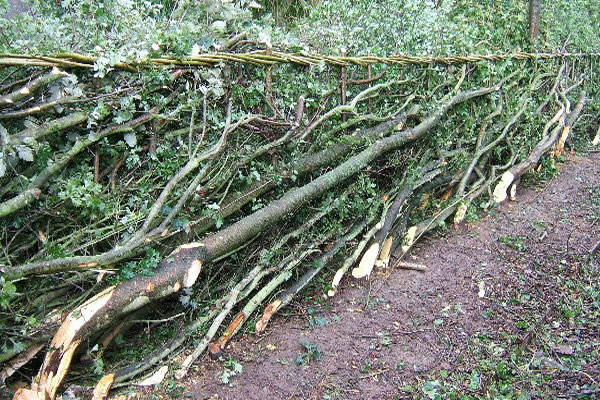Hedge Laying

Hedgerows are a key feature of our landscape and an important wildlife habitat
Country hedges need to be maintained and managed and recreated where they have been grubbed out. Traditional hedges served many functions:
- Hedges are stock-proof to contain livestock
- Hedges act as shelter for livestock and wildlife
- Hedges act as windbreaks for orchards
- Hedges act as boundary markers
- Hedges provide food for wildlife
Knowing what you want your hedge to do will enable you to decide what to type of hedging to use. Here's some examples:
Stock Proof Hedging
Use prickly plants such as Hawthorn and Blackthorn. This will deter livestock trying to get through them.
Hedges for Shelter
Use mainly Hawthorn and Blackthorn, but add in an occasional Holly and Beech to provide cover in the winter. The latter are slow growers and laible to be nibbled by livestock, so need to be protected byplanting amongst the Hawthorn and Blackthorn for protection.
Boundry Hedge
You have a wide choice here, almost any shrub or small tree, apart from conifers, will lay, including Lilac, Crab Apple, Cotoneaster, Perry Pear and so on.
Use those that grow best in your area, so that there are some colourful leaves, flowers, stems visible in places all year round.
Ground Preparation
If possible, dig (or plough a couple of furrows) on the hedge line and incorporate well-rotted manure in Spring/Summer, allowing the soil to settle in Autumn / early Winter, then plant up January/February. (NOTE: if you wish to use weed killer on the dug ground before planting, ensure it is a type that is neutralised on contact with soil.)
If you have to dig holes and plant at the same time, dig the hole deeper than needed, put a dollop of manure in the bottom and cover it with soil before putting the plant in. Manure 'burns' young roots, but they will find it when needed, and by then worms will have mixed it well with the soil.
Buying Plants
The garden centres sell hedge plants in small numbers – and high prices. Consult the agricultural press in January and find firms that sell plants by the hundred or thousand. The more you buy, the cheaper each individual plant becomes.The plants are bare-rooted. If they arrive during snow or frost, put them in a plastic bag, shake potting compost around them, water well and keep in a frost-proof place until conditions improve. Once in the bag, it is an idea to remove the wire or string from around the plants. The 12-18 inch plants transplant better, but for a quicker result, the 2-3 feet plants are better. The number you buy depends on how thick you want your hedge. You can plant in either a single or double row, plants spaced about 9 inches apart. A double row allows for occasional failure without obvious gaps forming.
Hedging Plants
Many other plants can be used and lay well, but have their disadvantages
- Horthorn – popular, thorny and inexpensive
- Blackthorn – popular, thorny and inexpensive
- Holly – Good evergreen
- Beech – Good for shelter
- Ash – grows fast, but makes an edible hedge
- Field maple – also edible and brittle to lay
- Oak – slow growing and edible
- Hazel – lays well, but laid stems don't last very long, though soon sends up replacement shoots.
- Rose – though prickly, is often eaten.
- Elderberry – never include as although they grow fast and lay well, they kill all other plants near them and thus destroy the hedge. Poisonous shrubs – yew, laurel, privet, must obviously be avoided.
- Sycamore – as above
Planting
Ensure roots are well spread and the plants are very firmly pressed in. After frost, press back any plants that have lifted.
Protecting the new hedge
The plants must be kept safe by a fence each side (wire or electric) about 3 – 4 feet away or very high. Even cows can develop giraffe-like necks! You can buy tubes for individual plants to protect them, but it comes expensive.
Care of the Growing Hedge
- Keep the weeds from smothering the plants, but a little grass around the base will protect the roots from the hot sun or hard frost.
- The sides can be trimmed so that they don't extend too far, but the top must be untouched.
- It is ready to lay when it is a minimum of twice the height of the laid hedge. (e.g.. Hedge required – 4 ft. high when laid, bushes must be a minimum of 8 ft. tall.) It is size, not age, that counts, Plants grow better in some areas than others. NOTE (1) If you are planting up gaps, the above instructions still apply.
Grow your own Hawthorn
You can grow your own hawthorn from berries quite easily.
- Collect fresh ripe berries & fallen leaves
- Place berries ON, not in, compost in seed trays
- Cover with fallen leaves
- Fix small mesh wire netting over each tray (anti mice & birds)
- Place trays on concrete by north facing wall and ignore them
- When seedlings appear & are big enough, transplant them into very deep trays or open ground, a distance between plants, feed, water, etc., as for any young plant.
- When 18 inches tall transplant them into hedge.
